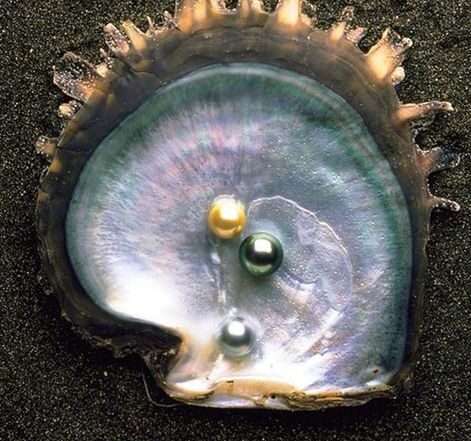
Appearance
Pearls are round or asymmetrical structures that form in the soft tissue of some mollusks, usually mussels and oysters.
Geographical Distribution
Pearls can develop in freshwater or saltwater habitats in a variety of bivalves (clams) belonging to the Mollusca phylum. Freshwater pearls can be found in Scotland, China, and nearly any reasonably big river in a temperate climate. In the United States, they are mostly found in the tributaries of the Mississippi.
Chemical Composition
These gemstones are made of layers of aragonite, or calcium carbonate crystals, and a protein known as conchiolin. The combination of these components and external influences results in the distinctive visual features of the pearl.
Types
Pearls can be divided into two categories: cultured pearls and natural pearls.
Natural Pearls:
Natural pearls originate only from natural processes, devoid of any human involvement. They are quite uncommon and arise from the accidental penetration of an irritant into the mollusk. A natural pearl can take years or even decades to form, and the final product’s size, shape, and quality are frequently unpredictable.
Cultured Pearls:
The process of creating cultured pearls requires human involvement. A tiny nucleus, usually a mother-of-pearl bead or a fragment of mussel shell, is delicately placed into the mollusk’s tissue during the pearl-farming process. The mollusk uses this irritant as a core around which to deposit layers of nacre, mimicking the natural process of pearl creation. The regulated setting of pearl cultivation yields more consistent outcomes in terms of pearl dimensions, form, and quality.
Pearls come in a variety of varieties, each having distinctive qualities, hues, and places of origin.
An outline of some of the most well-known varieties of pearls is provided below:
Freshwater Pearls:
Freshwater mussels are used to cultivate these pearls. Typically, they are made in a variety of forms, such as irregular, oval, and round. Pearls from freshwater are renowned for their diverse color spectrum, encompassing shades of white, pink, lavender, and even metallic tones. When compared to other kinds of pearls, they are frequently more economical.
Akoya Pearls:
Saltwater oysters are used to cultivate akoya pearls, mostly in China and Japan. Their clean surface, excellent luster, and traditional round shape make them highly valued. Traditionally, akoya pearls have overtones of pink or silver and are white or cream in color.
South Sea Pearls:
The largest and rarest kind of oyster, Pinctada maxima, is the source of these pearls. South Sea pearls are distinguished by their satin-like luster and are usually greater in size than other types of pearls. They are available in gold, silver, and white tones.
Tahitian Pearls:
Tahitian pearls, sometimes referred to as black pearls, are cultivated in French Polynesia in black-lipped oysters. In spite of their name, they are available in a variety of dark hues, such as peacock, grey, black, and green. They are in great demand due to their distinctive colors and overtones.
Baroque Pearls:
The asymmetrical, erratic shapes of baroque pearls can range from coin-shaped to elongated or abstract forms. They are frequently utilized in imaginative and artistic jewelry creations and are available in both freshwater and saltwater kinds.
Keshi Pearls:
Keshi pearls form in the pearl sac without the presence of a nucleus, making them non-nucleated pearls. Both freshwater and saltwater mollusks contain them. Keshi pearls are small and can be different colors and forms. Their organic and natural appearance is well-known.
Mabe Pearls:
Mabe pearls, also known as blister pearls, are produced by affixing an oyster’s nucleus to its inner shell as opposed to enclosing it in the soft tissue. As a result, a flat-backed pearl is produced, which is frequently used to make rings, pendants, and earrings.

Uses
For centuries, pearl jewelry has been appreciated for its classic beauty and grace. Pearls are used in a variety of ways to create beautiful jewelry items, from traditional pearl strands to cutting-edge and contemporary designs. These are a few:
- Pearl Necklaces: The most well-known and traditional application of pearls in jewelry is probably in necklaces. They are available in a variety of styles and lengths, including matinee, opera, choker, and princess. A classic in many jewelry collections is a single pearl strand, frequently fastened with a simple clasp.
- Pearl Earrings: Pearl earrings come in a variety of designs, such as hoops, dangles, and studs. They come in a variety of pearl varieties, hues, and sizes, making it easy to match them to various ensembles and events.
- Pearl Bracelets: Pearl bracelets give the wrist an air of refinement. They can be crafted from a variety of pearl varieties and hung on elastic, wire, or silk cords. In certain designs, pearls are used in combination with other gemstones or in many strands.
- Pearl Rings: Pearl rings can be both elegant and contemporary. Pearl rings can be stylish and modern at the same time. They are available in settings with diamonds or other gemstones, in clusters, and in solitaire designs. Pearl engagement rings are emerging as a distinctive option for individuals looking for something different from conventional diamond rings.
- Pearl Pendants: A single pearl or a cluster of pearls hanging from a chain is the focal point of a pearl pendant. Depending on the design, they might be intricate and ornate or plain and minimalist.
- Pearl Brooches: Pearl brooches give outfits a hint of sophistication and vintage appeal. Pearls of different shapes and sizes can be seen in them; frequently, they are paired with other ornamental components.
Table





